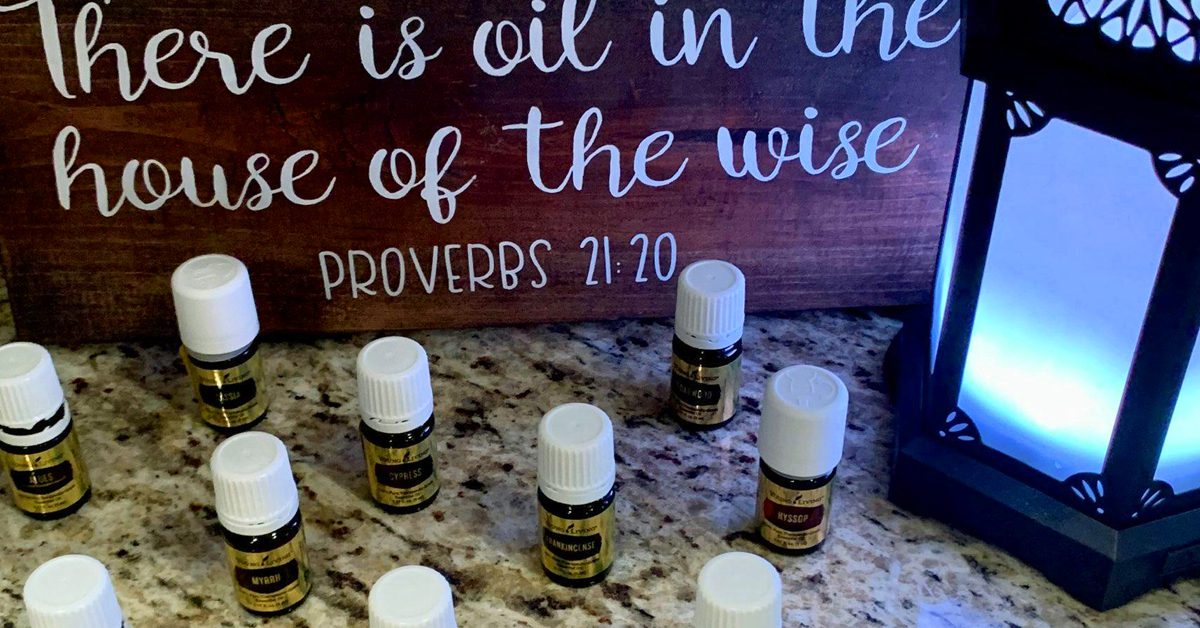
Did you know that the Bible describes over 33 different essential oils and aromatic plants and mentions over 1000 applications! Some people even claim God our Father to be the very first aromatherapist. Well that makes sense when you think about the first things that God did for the benefit of all living beings… He created fragrant plants… He created paradise. In the book of Genesis, it is spoken on how God designed this wonderful, fragrant garden for all people, animals and living beings… God said, “See, I give you every seed-bearing plant all over the earth and every tree that has seed-bearing fruit on it to be your food, and to all the animals of the land, all the birds of the air, and all the living creatures that crawl on the ground, I give them green plants for food.” And so it happened. God looked at everything He had made, and He found it very good. Genesis 1:29-31
The Oils of Ancient Scripture contains 10 oils of scriptures, from Cypress (Isaiah 44:14) to the “Rose of Sharon” (Song of Solomon 2:1). The grounding scents of Myrtle and Cedarwood and the rich fragrance of Frankincense and Myrrh. Explore these oils in scripture and ways you can benefit from their use today.
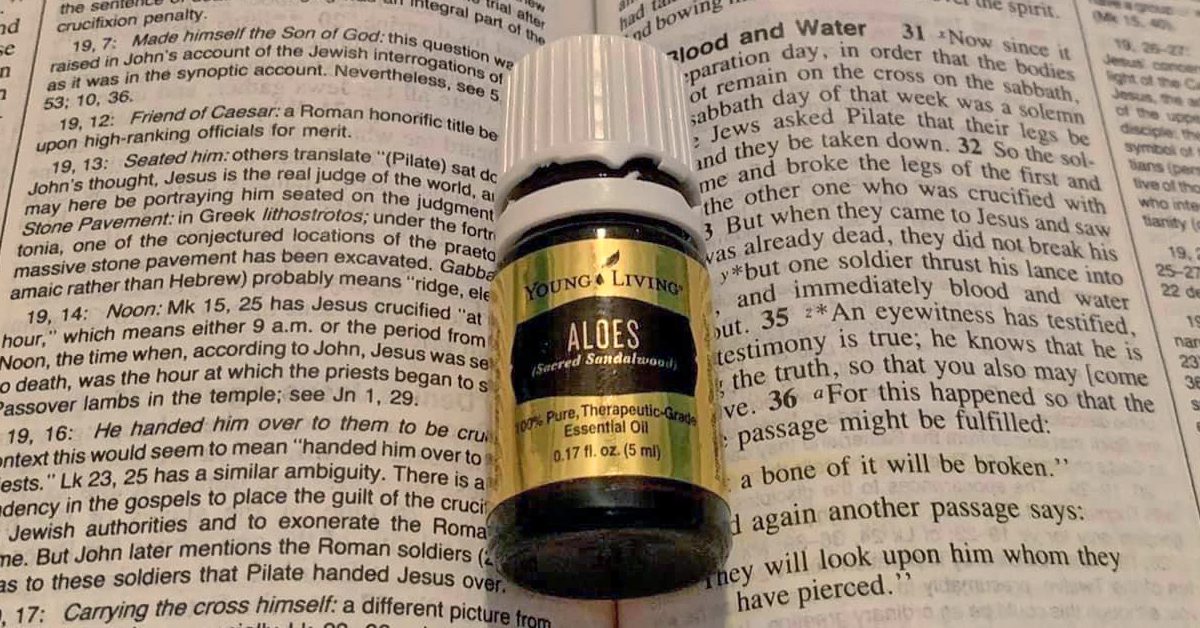
Aloes (Sacred Sandalwood)
Santalum album
Aloes ( Sandalwood) oil comes from the most valuable tree in the world. The central part of the tree .. the heartwood… is used in the distillation process to create the deeply aromatic oil. The Sandalwood tree is considered a “ parasitic” tree as it taps into the roots of other species for water and nutrients. The best quality oil is obtained from an old tree near the end of its life.. It takes at least 7-10 years for a Sandalwood tree to form heartwood. Most Sandalwood trees are left to mature for at least 15-20 years before they are harvested, which allows the valuable heartwood to grow to a larger size. While Sandalwood is sometimes harvested for its wood, its most precious product is its oil. King Tut’s tomb was filled with alabaster jars of aloe/ Sandalwood oils which thieves later stole, leaving the alabaster jars behind.
Sandalwood oil is high in sesquiterpenes (95%) which have calming, bactericidal and anti inflammatory properties. The scent of Aloes/ Sandalwood supports a deep relaxation of the nervous system while helping with clear thinking and focus…. One of the reasons it is used during prayer and meditation. Today we also find that Sandalwood is commonly used for skincare (Sandalwood is a natural astringent) and it’s also a bedtime favorite as it enhances good sleep.
In scripture we read about a plant called “aloes”. But this is not the aloe plant we think of in terms of a cactus with a gooey substance inside to sooth wounds. But rather this early aloewood is likely to be what we now call Sandalwood.
“Like valleys they spread out, like gardens beside a river, like aloes planted by the Lord, like cedars besides the waters.” Numbers 24:6
In Psalm 45:8-9, Sandalwood was mentioned as a perfume called the “oil of gladness” along with myrrh and cassia. This same combination was again mentioned in Proverbs 7:17, “I have sprinkled my bed with myrrh, with aloes and with cinnamon.” Sounds pretty amazing so I made a roller blend with aloe, cassia and myrrh… I’ll put the recipe in the comments so you too can experience and use the “oil of gladness”
We also find Aloes mentioned in Song of Solomon 4:14, “Nard and saffron, calamus and cinnamon, with all kinds of incense; Myrrh and Aloes, with all the finest spices.”
But perhaps the most important verse that mentions Aloes is found in the Gospel of John, chapter 19, verse 39. Here we read of Joseph and Nicodemus using Sandalwood (Aloes) to preserve Jesus’s body. With Pilate’s permission, Joseph accompanied by Nicodemus takes the body of Jesus away. “And there came also Nicodemus, which at first came to Jesus by night, and brought a mixture of Myrrh and Aloes, about 100 pound weight.”
This mixture would have been very costly. This volume of oil would equal to around $150,000 -200,000 dollars in today’s market.
Wow! Joseph and Nicodemus must have really loved Jesus. We know that Joseph of Arimathea was an extremely wealthy and prominent man within the Jewish community who had secretly become a follower of Jesus. He risked a lot in requesting Jesus’ body and placing Jesus in his own tomb.
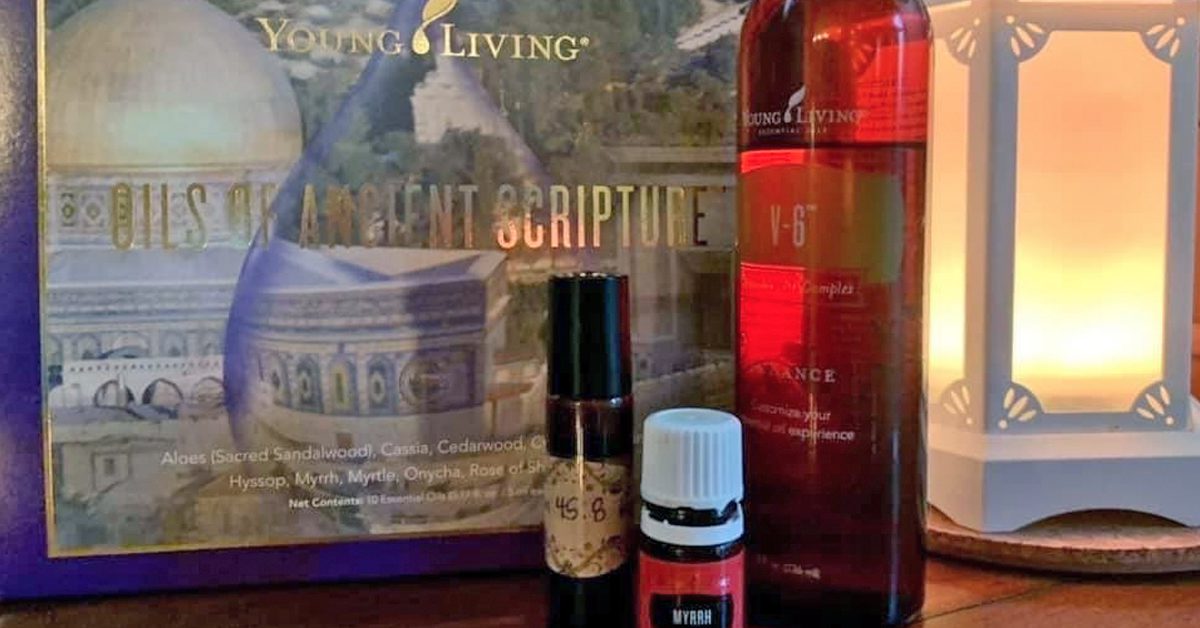
*Psalm 45:8 Inspired Roller Blend
“Oil of Gladness,” “Oil of Joy”
“ All your garments smell of myrrh, aloes and cassia, out of the ivory palaces, whereby they have made you glad.” Psalm 45:8, King James Version.
“You love justice and hate wrongdoing; therefore go, your God has anointed you with the oil of gladness above your fellow kings. With myrrh, aloes and cassia your robes are fragrant. From ivory-paneled palaces stringed instruments bring you joy.” Psalm 45:8-9, Catholic Bible.
I wanted to share both versions so you could see there are differences depending on which translation you use. But they both point to Jesus. Greek “Messias” means “the anointed one.” This word is used in John 1:41 and John 4:25. The woman said to him, “I know that the Messiah is coming, the one called the Anointed; when he comes, he will tell us everything.”
But what is anointing? To “anoint” someone is to cover them with “an ointment”. It means to cover, rub or smear the head with oil or in some cases it means to pour oil over the head and body. The Hebrew word for anoint is “mashach” which is similar to the English word massage. Mashach (to anoint) is used over and over in the Old Testament to talk about anointing the temple and priests. “Messias” is based on the Hebrew word “mashach”, the noun version of the above for “anointed.”
Ingredients & Supplies:
- Cassie 2 drops
- Aloes 6 drops
- Myrrh 6 drops
- 10ml amber glass roller bottle
Top off with V6 or a carrier oil of your choice. Wear as your perfume and be inspired… Psalm 45:8 roller smells “Heavenly.”

Cassia
Cinnamomum cassia
“Oil of Gladness”
*Cassia is one of the oils in God’s Holy Anointing oil described in Exodus 30:22-31
The Lord said to Moses, “ Take the finest spices: five hundred shekels of free flowing myrrh, half that amount, that is, two hundred and fifty shekels of fragrant cinnamon; two hundred and fifty shekels of fragrant cane; five hundred of shekels of CASSIA- all according to the standard of the sanctuary shekel; together with a hon of olive oil…”
According to the Jewish Bible, 500 shekels is about 12.5 lbs while a sanctuary him is about 1 gallon.
Cassia comes from a slender, evergreen tree which grows up to 20 feet tall and is native to southern China. It’s steam distilled from the bark of the tree. Cassia is closely related to cinnamon… they both come from 2 species of the same genus. Cassia is very similar to cinnamon but cassia is considerably stronger (hotter). Always use a carrier oil when using cassia!
Think of how far Cassia had to travel to get to the Middle East… this was an expensive oil! Ezekiel 27:19 lists Cassia as a trading commodity along with wine, wrought iron and calamus (aromatic cane).
We also see Cassia mentioned in Psalm 45:7-8 …by anointing you with the oil of joy. All your robes are fragrant with myrrh and aloes and cassia; from palaces adorned with ivory the music of the strings makes you glad.”
Historically, Cassia has been called an “oil of gladness” for its emotional uplifting effects. Cassia was also used to support the immune system and the digestive system and historically has been connected to improving blood circulation. It’s worth noting that a state of cheerfulness or joy is elevating to the immune system, helping to protect you from illness! It’s well know that our emotional state is a key element to our state of health. When we inhale a fragrance, odor molecules stimulate nerve cells, sending electrical impulses to the olfactory bulb in the brain; signaling the limbic system… the control center for our emotions. The Limbic system also controls heart rate, blood pressure, breathing, stress levels and hormone balance. Upon inhaling a scent, the limbic system responds by releasing hormones and neuro chemicals such as serotonin .. the HAPPY hormone.
Cassia is also mentioned in one of the oldest known medical records… Ebers Papyrus, an Egyptian compilation of medical texts. Cassia essential oil can only be found in the Oils of Ancient Scripture!
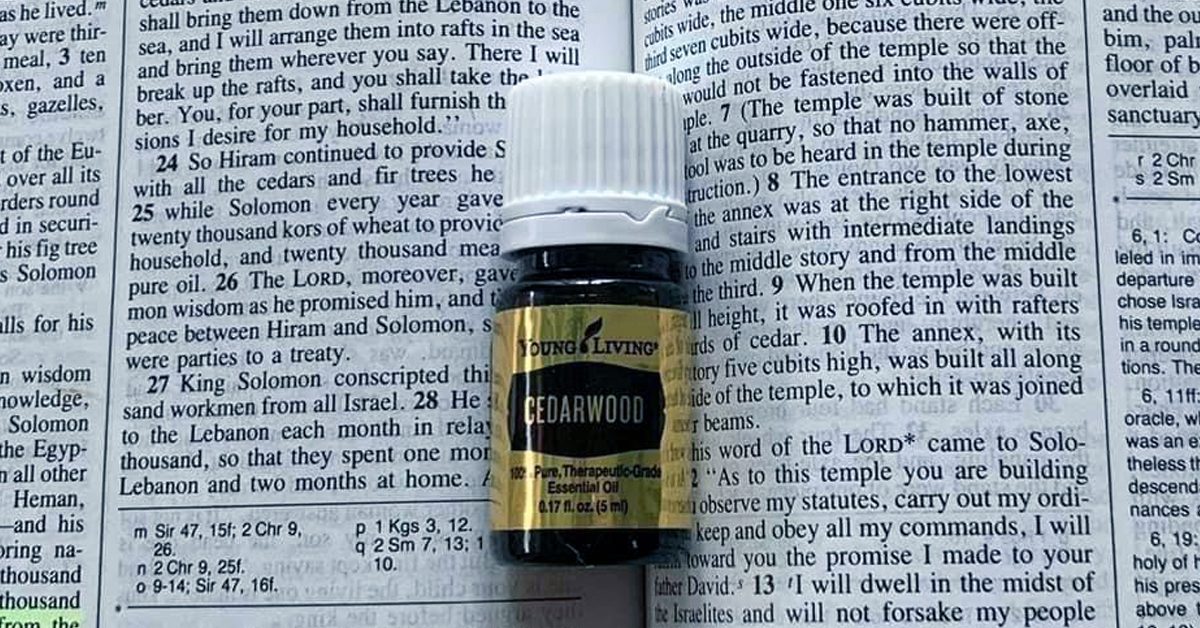
Cedarwood
Cedrus atlantica
*Cedarwood is believed to be the very first essential oil ever distilled! It was used for cleansing of lepers, ritual cleansing after touching a dead body or anything unclean and ritual cleansing of evil spirits. Egyptians and Sumerians used Cedarwood in their embalming process over 5000 years ago! They also used the oil for medicinal purposes, insect repellent, mental enhancement and the wood to build temples, instruments, boats, coffins and dwellings.
The “Cedars of Lebanon” were magnificent, towering trees which could live as long as 2000 years. Some of the trees alive in King David’s time would have still been alive in the time of Jesus… or think about this.., Cedars that were seedlings in Jesus’ time may still be alive today, hidden away in the rugged mountains of Lebanon! In King David’s day, when he wrote Psalms 104:16, “The Cedars of Lebanon” we’re considered to be the “trees” of the Lord, that He planted! In 1 Kings, chapter 5, verse12- 13.. we hear King Solomon… Solomon also uttered three thousand proverbs, and songs numbered a thousand and five. He discussed plants, from the cedar of Lebanon to the hyssop growing out of the wall, and he spoke about beasts, birds, reptiles, and fishes. If you are using the NIV Bible, you’ll find this verse in 1 Kings 4:33.
Unfortunately, today, the Cedars of Lebanon ( Cedrus libani) are endangered and a protected species no longer available for their lumber or oil. Today Cedarwood oil is extracted from Cedrus atlanticus, a species most similar to the Biblical cedars. Young Living’s Cedarwood oil comes from Morocco and is steam distilled from the bark of the tree.
We see that Cedarwood is mentioned throughout scripture, often used as wood for the building of temples and palaces. In fact, King David and his son, King Solomon’s places and temples were built of cedar. In the book of Kings, King Solomon was given specific instructions from God about the building the temple, the “House of the Lord”. When Solomon finished his building the temple, its walls were lined from floor to ceiling beams with cedar paneling… the cedar in the interior of the temple was carved in the form of gourds and open flowers; all was of cedar…. He made in front of the sanctuary a cedar altar. 1 Kings 6:15,18, 21
Cedarwood is very durable, but I think God had another reason for instructing Solomon to use Cedarwood… its aroma!!! We know that Cedarwood oil has the highest amount of sesquiterpenes (98%). Sesquiterpenes are hydrocarbon constituents of essential oils that increase your ability to think clearly and enhance your awareness needed for effective prayer and meditation! While helping with focus, Cedarwood also elevates your mood while calming you at the same time. Have you ever found yourself in a room built entirely of wood? No laminate or concrete… just wood. Now perhaps you can imagine how King Solomon felt as he smelled the aroma of Cedarwood which lingers in the air for years. God knew the scent of Cedarwood would help Solomon rule with a clear head and a humble heart. Incredible.. I get goosebumps when I think about God’s divine plan and how He works in our lives and hearts. God is so good!
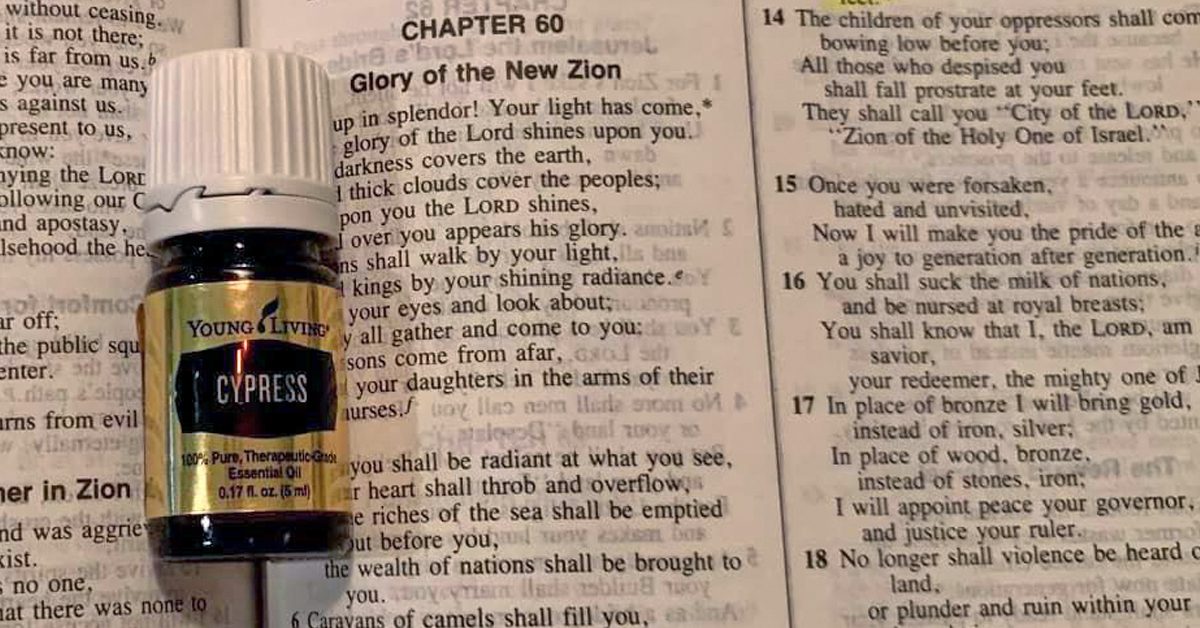
Cypress
*(Cupressus semipervirens)
Ah, you are beautiful,my beloved,
ah, you are beautiful; your eyes are doves!
Ah, you are beautiful, my lover,
yes, you are lovely.
Our couch, too, is verdant,
the beams of our house are cedars, our rafters, cypresses.
Song of Solomon 1:15-17
Cypress oil is extracted from the cypress tree which has wood so durable that the cypress doors of Rome’s St. Peter’s Basilica show no sign of decay even after 1,200 years! Cypress is another oil (like Cedarwood) we find in scripture used as building material for temples and other structures. It’s wood is hard and fragrant. Emotionally, Cypress promotes feelings of security and stability… perfect for the floors of the temple.
Cypress trees were common place in biblical times. The Phoenicians and Cretans used Cypress for building ships and houses, the Egyptians made their sarcophagi from the hard wood, and the Greeks used Cypress to carve statues to their gods.
I will plant in the desert the cedar, acacia, myrtle , and olive;
I will set in the wasteland the cypress, together with the plane tree and the pine.
Isaiah 41:19
The cypress tree is one of the tallest trees in Palestine with its branches reaching to heaven and is often associated with death and the hope of heaven. In Biblical times, Cypress trees were planted in Mediterranean cemeteries, symbolizing that life after death had begun. Cypress trees are still commonly seen at cemeteries around the world.
Did you know that according to sacred tradition, the True Cross of Jesus was made from 3 different types of wood… one of which is Cypress! This is alluded to in Isaiah 60:13, “The glory of Lebanon shall come to you: the cypress, the plane and the pine. To bring beauty to my sanctuary, and glory to the place where I set my feet. “ The link between this verse and the crucifixion lies in the words “the place of my feet” which is interpreted as referring to the “foot rest” on which Jesus’ feet were nailed. To read more see Wood of the Cross >
The oil of Cypress has been used since ancients times for purification and as incense. Historically Cypress was known for being supportive of the cardiovascular and immune systems as well as being rich in monoterpenes. Cypress’ herbaceous, fresh woodsy scent has a grounding and stabilizing effect as do most of the tree oils including Cedarwood and Palo santo. Our ancient friends would have used it for arthritis, laryngitis, scar tissue and cramps. Records dating back to 1800BC mention Cypress oil. Today we know Cypress is incredible for blood circulation and cardiovascular health as well as supportive of women during menstruation and menopause.
The Greek word “semipervivens” for which cypress’ botanical name is derived means “live forever.” How fitting then … that cypress is one of the essential oils found in YL’s blend called “Aroma Life”
“So make yourself an ark of cypress wood; make rooms in it and coat it with pitch inside and out.” Genesis 6:14

*Frankincense
Boswellia carterii
What is coming up from the desert, like a column of smoke
Laden with myrrh, with frankincense, and with the perfume of every exotic dust?
Song of Solomon 3:6
Did you know that Frankincense and Myrrh are the two most commonly mentioned oils in scripture? The specific word Frankincense occurs 16 times, but the word “lebonah” which is Hebrew for Frankincense, occurs in 6 other places where it is translated as “incense”. In Exodus 30, we read about how Frankincense is a part of the “Holy Incense”. God gives Moses instructions on how the incense should be made through a “holy recipe”.
The Lord told Moses, “Take these aromatic substances: storax and onycha and galbanum, these and pure Frankincense in equal parts; and blend them into incense. …. This incense shall be treated as most sacred by you.
Exodus 30:34-35,36
The Holy Incense was part of the temple traditions and served other purposes as well. In Numbers, chapter 16, we read of a plague the Lord sends to destroys the Israelites, but Aaron filled his censer with the Holy Incense and stood between the living and the dead, raising the burning censer making atonement for them and the plague stopped.
The purpose of incensing is one of purification and sanctification (the removal of sin). One of the ways this happens is through prayer. In the Old Testament, prayer is connected with purification.. The smoke symbolizes the prayers of the faithful drifting up to heaven … a sweet aroma rising up to God:
“Let my prayer be incense before you; my uplifted hands and evening sacrifice.”
Psalm 141:2
“Listen to me, O you holy sons, and bud like a rose growing near a stream of water; send forth fragrance like frankincense, and sing a hymn of praise; bless the Lord for all His works.
Sirach 39:13-14
Isaiah, chapter 60 prophesies the coming of Jesus through the use of beautiful imagery and foretells His impact on Earth.
Nations shall walk by your light,
and kings by your shining radiance. …
All from Sheba shall come bearing gold and Frankincense, and proclaiming the praises of the Lord. Isaiah 60:3, 6
Incense also creates the ambience of heaven. In the book of Revelation we read about the heavenly worship:
“Another angel came in holding a censor of gold. He took his place at the altar of incense and was given large amounts of incense to deposit at the altar of gold in front of the throne, together with the prayers of all God’s holy ones. From the angel’s hand, the smoke of the incense went up before God, and with it the prayers of God’s people.” Revelation 8:3-4
Today incense is still used in the Catholic liturgy. The most prevalent ingredient in the Roman Catholic incense is Frankincense and sometimes myrrh. When we see incense at Mass, it should remind us that our worship of God is divine in origin. Incense also reminds us that our prayer rises to God like the smoke from the censer, purifying our worship of Him.
“The usage of incense adds a sense of solemnity and mystery to the Mass. the visual imagery of the smoke and the smell remind us of the transcendence of the Mass which links heaven and earth, and allows us to enter into the presence of God. “ Fr. William Saundersnone
Here is a video of the largest, world famous censer in the world weighing 80kg (176 lbs) and holding 40kg (88 lbs) of charcoal and incense found at the St. James Cathedral in Spain. Watch video >
In the Gospel of Matthew, we find the most famous text in the Bible regarding essential oils .. specifically Frankincense and myrrh.. which is known even by people who have never opened a Bible…
“And on entering the house they saw the child with Mary his mother. They prostrated themselves and did Him homage. Then they opened their treasures and offered Him gifts of gold, Frankincense, and myrrh.”
Matthew 2:11
Historically, Frankincense was used to anoint newborn sons of kings and priests. Truly the “Three Wise Men” were wise indeed, and knew the majesty of baby Jesus.
As essential oils were a normal thing at that time, Mary would have known exactly what to do with these precious gifts. She would have known how to use the myrrh (great for stretch marks and the umbilical cord care) and Frankincense to support a new mother’s healing skin. She would have also understood that Frankincense is a healing oil good for almost anything from cuts to the common cold. She would have used it throughout Jesus’ infancy to help protect him and keep him strong and healthy. This is why the Gospel of Matthew doesn’t bother to elaborate on the application and benefits of Frankincense and myrrh as it was common knowledge. Who could have imagined at that time, that thousands of years later, all knowledge from that time was lost, and here we are today having to show people essential oils are safe and beneficial.
The emotional, comforting properties (that help one overcome grief and stress) of Frankincense oil would have been helpful as Mary and Joseph headed into Egypt, fleeing from Herod and the massacre of the innocents.
Egyptian tradition says that Frankincense is good for everything from gout to a broken head or in other words “good from head to toe”… used to treat every conceivable ill known to man. When in doubt use Frankincense!! Frankincense was valued more than gold during ancient times, and only those with great wealth and abundance possessed it. Did you know that Frankincense oil was found in King Tutankhamen’s tomb in Ancient Egypt? King Tut died in 1323 BC!
Frankincense is mentioned in one of the oldest known medical records, Ebers Papyrus, an ancient Egyptian list of over 800 prescriptions and recipes. Ebers Papyrus prescribed Frankincense as a use for throat infection, asthma, bleeding, and vomiting, among other things.
Frankincense starts as a resin which is extracted from the Boswellia tree. Frankincense also known as olibanum or “Oil from Lebanon” was harvested as a dry resin and steam distilled to create an oil for perfumes or skincare. Ancient Chinese medicine recommends the use of Frankincense and Myrrh as an antibacterial.. In addition to religious and medicinal purposes, Ancient travelers in the Middle East used Frankincense to suppress their appetite when food was scare. They also chewed it to clean their teeth. Egyptians referred to Frankincense as the “sweat of gods” and used it for perfume, insect and vermin repellent and to mask the rotting odor when embalming bodies. The dark eyeliner worn by Egyptian royalty was made from the charred powder of burned Frankincense resin. Today you can find Frankincense as one of the ingredients in “Old Spice” cologne!
Let’s talk a little bit more about how Frankincense is gathered as resin from trees as I find it quite fascinating. Frankincense is harvested by “wounding” the tree in a process called “resin tapping”. Harvesters who are well trained in this practice will slit the tree so that the sap runs. This sap runs to the surface to heal the tree “wound”. The harvesters then collect the hardened resin; repeating the process three times over the same spot on the tree. Only after the tree is wounded and bleeding does it create the life- giving resin… It reminds me of how Jesus shed his blood and died for us on a tree… His blood covered our sins and transgressions… “all have sinned and are deprived of the glory of God. They are justified freely by His Grace through the redemption in Christ Jesus, whom God set forth as an expiation, through faith, by His blood, to prove his righteousness because of the forgiveness of sins previously committed.” Romans 3:23-25
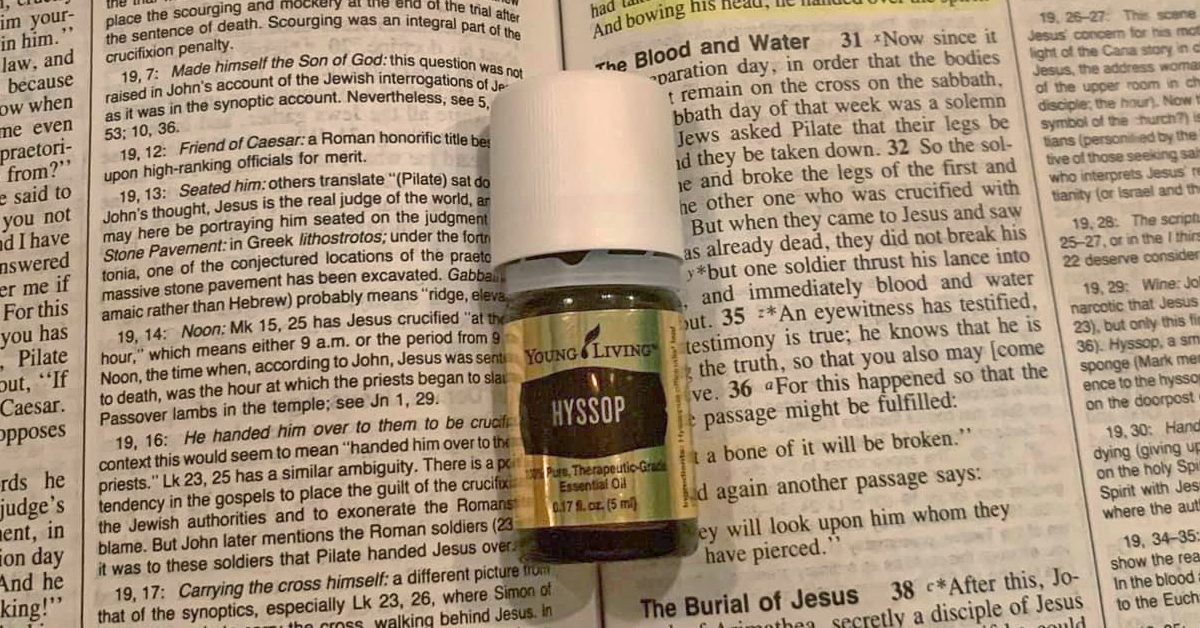
Hyssop
Hyssopus officinalis
Hyssop comes from the Hebrew word “ezob” meaning “holy herb”. The Hyssop genus (hyssopus) belongs to the mint family (Lamiaceae) of flowering plants and contains several species of herbaceous perennials. At least 18 different plants have been considered for the hyssop of the Bible. In fact, Hyssop has been the subject of considerable controversy on the part of botanists and Biblical scholars in days gone by, as well as the present. While the true identification may not be known, biblical references indicate a cleansing property. Mentioned twelve times in scripture, Hyssop was primarily used for ritual cleansing, ceremonial offerings and forgiveness of sins.
Cleanse me with hyssop, that I may be pure; wash me, make me whiter than snow.
Psalm 51:9
In Leviticus 14, we find instructions for a ritual cleansing of lepers involving Cedarwood and Hyssop…
The Lord said to Moses, “This is the law for the victim of leprosy at the time of his purification. He shall be brought to the priest, who is to go outside the camp to examine him. If the priest finds that sore of leprosy has healed in the leper, he shall order the man who is to be purified, to get two live, clean birds, as well as some Cedarwood, scarlet yarn, and Hyssop. Leviticus 14:1-4
The use of Hyssop oil for cleansing (inhaled and applied to the body) has a scientific basis. Hyssop is about 50% ketones, which act like phenols and cleanse receptor sites. Ketones are known to be calming emotionally.
In the book of Exodus, Moses begins negotiating with Pharaoh to “Let my people go!” Pharaoh refuses and the Egyptians are then subjected to 10 plagues sent by God. The 10th plague is on the firstborn. To protect themselves, the Lord instructs Moses and Aaron to take a “perfect lamb” and slaughter it.
“Go and procure lambs for your families, and slaughter them as Passover victims. Then take a bunch of hyssop, and dipping it in the blood that is in the basin, sprinkle the lintel and the two doorposts with this blood.”
Exodus 12:21
Every firstborn son in Egypt would die.. Egyptians and Israelites .. except for those who were in their homes, “under the blood of the lamb”. They would be “passed over” by the angel of death. When striking the door posts with blood, the Hyssop leaves would be bruised, releasing the scent of the oil. The Israelites would have smelled the blood intermingled with the crisp scent of Hyssop as they protected their homes.
The Old Testament ritual of Passover foreshadows Jesus’ crucifixion where we read about the use of Hyssop once again. Jesus is the New Testament “Passover Lamb”
After this, aware that everything was now finished, in order that the scripture might be fulfilled, Jesus said, “I thirst.” There was a vessel filled with common wine. So they put a sponge soaked in wine on a sprig of Hyssop and put it up to his mouth. When Jesus had taken the wine, he said, “It is finished.” And bowing His head, He handed over the spirit. John 19:28-30
The wine was lifted up to Jesus on a stalk of Hyssop. It is believed that the use of Hyssop at crucifixions may have helped in some small way to ease the suffering of those being crucified, as it is soothing to the lungs when inhaled. Death by crucifixion is death by slow suffocation. As the victim gradually tires, they can no longer lift themselves to breath. As their lungs slowly fill up with fluid, they die an agonizing death. The scent of Hyssop has long been known for its ability to bring respiratory relief. While the Roman soldiers were not known for their mercy, they did allow certain women of Jerusalem to bring narcotic-like mixtures to offer dying victims to ease their pain and suffering. In this case, perhaps Hyssop was brought by these women of mercy as an aromatic to help the crucified breath a little easier.
The next time you use Hyssop essential oil in your home, realize that you are inhaling the same scent that our Savior experienced as He gave His life as ransom for our sins.
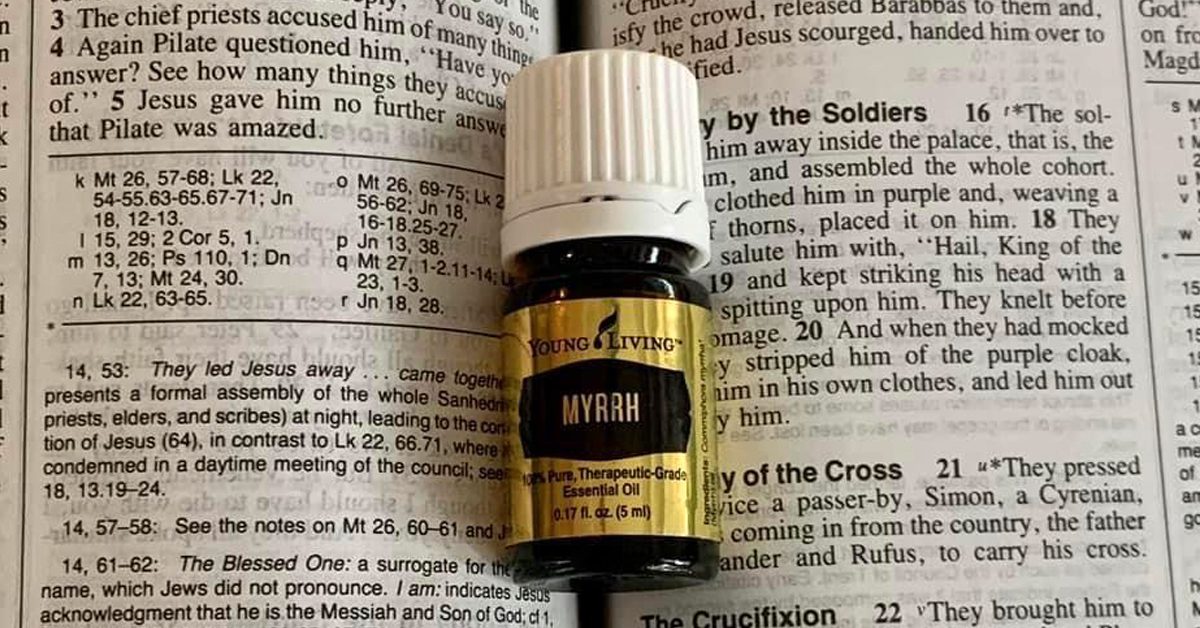
Myrrh
Commiphora myrrha
They were overjoyed at seeing the and on entering the house they saw the child with Mary, his mother. They prostrated themselves and did Him homage. Then they opened up their treasures and offered Him gifts of gold, frankincense and MYRRH. Matthew 2:10-11
Did you ever wonder why the magi chose MYRRH as one of the gifts for baby Jesus? Was myrrh a gift that symbolized the magi’s beliefs above the baby Jesus? His true identity and his future? Well we do know that MYRRH was also a gift for Mary.. She would have known to rub it on her abdomen as MYRRH is an incredible oil for supporting skin!! She would have known that myrrh was an antiseptic and should be placed on the baby Jesus’ navel to prevent infection and facilitate healing! She also would have known that MYRRH was good to soothe and heal little cuts and bruises of little boys.
Did you know that MYRRH was not only one of the first oils Jesus would receive in his time on earth.. but also the last?! They gave Him wine drugged with MYRRH but He did not take it. Then they crucified Him… Mark 15:23
When Joseph of Arimathea and Nicodemus came to prepare Jesus’ body for burial, they brought oils of sandalwood (aloes) and MYRRH weighing about 100 pounds. John 19:38-39. In today’s retail market that would be around $150,000- $200,000 of essential oils! Wow.
Did you know that MYRRH is referenced more than any other aromatic oil of the Bible?! MYRRH is actually mentioned 156 times…
MYRRH is mentioned as one of the main ingredients in The Holy Anointing Oil… “Take the finest spices: five hundred shekels of free flowing myrrh; half that amount, that is, two hundred and fifty shekels of fragrant cinnamon; two hundred and fifty shekels of of fragrant cane; five hundred shekels of cassis – all according to the standard of the sanctuary shekel; together with a him of olive oil ; and blend them into the sacred annointing oil.
Exodus 30:23-25
In Esther 2:12, Esther underwent purification and beautification.. Six months with the oil of MYRRH and six months with perfumes and cosmetics before her visit to the king. 12 months of preparation. Wow!
In biblical times, MYRRH was a commonly used oil.. We see it scattered throughout Scripture! MYRHH is even recorded in Ebers Papyrus, one of the oldest Egyptian texts on record! Ebers Papyrys dates back to around 1550 BC and contains over 700 remedies for almost everything including embalming!
If you’ve used MYRRH, you know it’s a very viscous oil! It’s like a honey and will thicken up over time. That is why in ancient times, MYRRH was often used as a “ fixative” or a base for most aromatic preparations!
In the fragrance business, a fixative is an oil that when mixed with oils, will FIX the odor.. causing the fragrance to last longer! MYRRH is one of the most effective “fixing oils” of all… Being used for thousands of year’s throughout the world!! In fact, MYRRH is still used as a fixative today and can be found in many popular perfumes and colognes today.
Perhaps one of the most interesting or fascinating facts about MYRRH, for me anyway, is found in the pictures of ancient Egyptians. You’ve seen the pictures of Egyptians with cones on their heads.. And you may have thought as I did, that these were knots of hair… but they were actually lumps of fat from ox, duck, goose or yes even a hippopotamus that had been saturated with MYRRH.. The idea was to place the MYRRH cone on top of their heads in the morning and then as the heat rose during the day, the fat would melt slowly, running down their half naked bodies, keeping their skin moist and repelling insects!
Today we still know MYRRH as a servant oil to all other oils. Besides being a fixative that increases an aroma longevity.. MYRRH is also one of those great synergistic oils that enhances the qualities of any oil with which it is mixed! But it is also a wonderful, healing oil in its own right! MYRRH is high in sesquiterpenes…known to stimulate the limbic system, the seat of emotions and memory. So diffuse MYRRH for its restorative, uplifting aroma. You can find MYRRH in the Young living blends…. Gratitude, Humility and Hope!
Place a few drops in your moisturizer as it supports healthy skin. Add a few drops to your epsom salts for a relaxing and healing bath. Ahh. there are so many uses and benefits you too can experience with the “Gift for Jesus.”
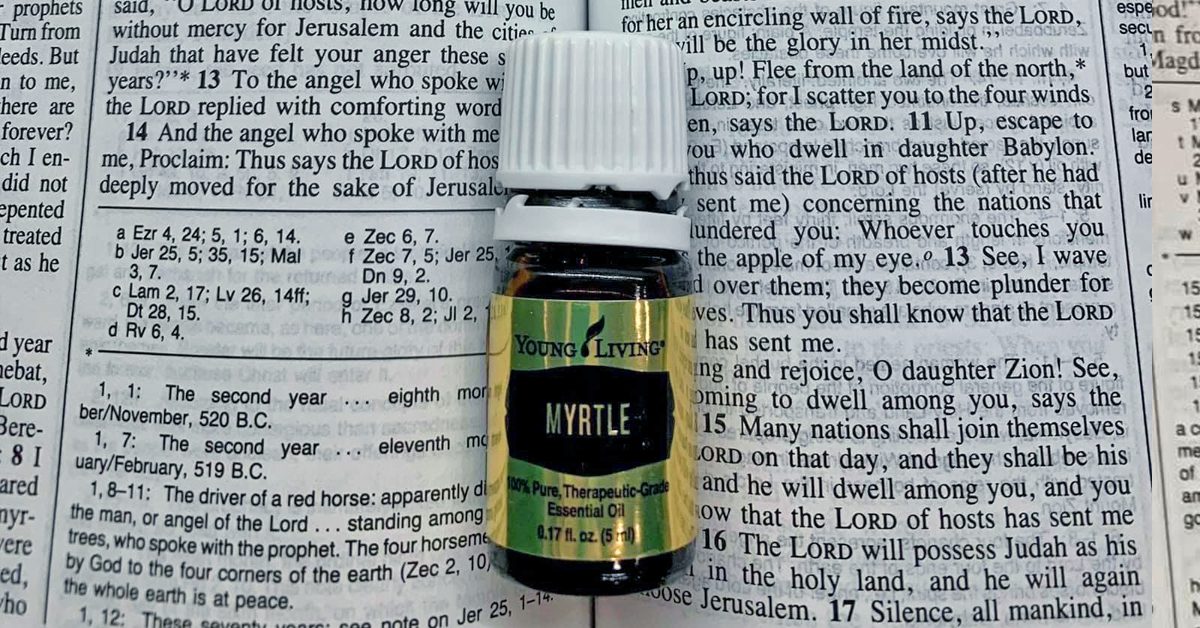
Myrtle
Myrtus communis
In place of the thornbush, the cypress shall grow, instead of nettles, the myrtle. This shall be to the Lord’s renown, an everlasting imperishable sign. Isaiah 55:13
Thornbush and nettles are suggestive of the desert and perhaps symbolize suffering and hardship. Cypress and Myrtle are suggestive of a fertile land, symbolizing JOY and STRENGTH.
Myrtle is a flowering aromatic evergreen bush or dwarf tree that can grow to be quite large (16 feet). Myrtle is native to the Mediterranean Europe, Middle East, North Africa and Turkey. Historically, Myrtle was primarily used in religious ceremonies for purification. Myrtle essential oil is steam distilled from the leaves and has a sweet, slightly camphor plus aroma with a light floral overtone. Myrtle essential oil is incredibly supportive of the endocrine system, specifically the thyroid. It’s also wonderful for respiratory support and amazing at opening up your airways. Rub over your throat and chest with a carrier oil and take a deep breath…
Myrtle is mentioned six times in scripture … but perhaps the two most fascinating are in the book of Nehemiah and Esther.
First we read about Myrtle and it’s role in the “Feast of the Tabernacles” also known as Sukkot (Feast of Booths). Historically the Feast of the Tabernacles commemorates the end of the Exodus (40 years of the Israelites wandering in the desert between Egypt and the Promised Land).
“Go out into the hill country and bring in branches of olive trees, oleasters, Myrtle, palm, and other leafy trees to make booths, as the law prescribes.” Nehemiah 8:15
The word “sukkot” means “booths”. Throughout the pilgrimage festival, the Jewish people built temporary shelters just like the Hebrew people did while wandering in the desert. It was to remember and celebrate their deliverance from Egypt by the hand of God. In Jewish liturgy and the Feast of Tabernacles, there are four sacred plants used during Sukkot to represent the four different types of personalities making up the community. One of the sacred plants was Myrtle, known for its pleasing fragrance but unpleasant taste. Myrtle represents those community members known for their good deeds but who do not know or observe the law of the Lord. It is a symbol of righteousness and a reminder that actions without obedience to God’s law are empty!
The second place Myrtle shows up in Scripture as an interesting study topic is in the book of Esther. In Hebrew, the word for Myrtle is the feminine form of “hadas”, Hadassah. Hadassah is Queen Esther’s Jewish name!
She was called Hadassah (Myrtle) because the righteous are compared to Myrtle.
In the book of Esther we read about this Jewish heroine who saved her people from annihilation during the reign of King Xerxes. We read about how she had to complete twelve months of extensive ritual beauty treatments that included six full months of Myrrh oil and six months with perfumes and cosmetics… all before she could come before the King. See Esther 2:12
Imagine using Myrrh oil for 6 months… it’s so amazing for the skin.. yes please! Esther wins the favor of King Xerxes and becomes his Queen.
Later, Esther learns from Mordecai (her wise uncle) of the King’s advisor’s plan to destroy the Jews in Persia, Mordecai insists Esther break protocol and enter the King’s presence without being called first… doing so she would have risked death! Esther declined and instead asked the Jews to fast for her. This was Mordecai’s response..
“Even if you now remain silent, relief and deliverance will come to the Jews from another source; but you and your father’s house will perish. Who knows but that it was a time like this that you obtained the Royal dignity?”
In other words.. perhaps you were born for such a time as this! After hearing this, Esther responds with fasting and prayer and sends Mordecai this response…
“Go and assemble all the Jews who are in Susa; fast on my behalf, all of you, not eating or drinking, night or day, for three days. I and my maids will also fast in the same way. Thus prepared, I will go to the king, contrary to the law. If I perish, I perish!” Esther 4:16
The Lord used this gentle, obedient woman to save His People. Esther proves to be a woman of incredible courage and humility.. strong and knowledgeable… “As Myrtle spreads it’s fragrance in the world, so did she spread good works.” Esther went before the king and stepping into the hard place, takes a chance, trusting in the Lord.
“Trust in the Lord with all your heart, on your own intelligence rely not;
In all your ways be mindful of him,
and He will make straight your paths. Proverbs 3:5-6
God doesn’t promise us a rose garden..But He does give us a WAY! His WORD.
In the beginning was the Word, and the Word was with God, and the Word was God. John 1:1
Set your foundation on The Lord just as Esther did in the good times and bad, so you will be prepared for the tough times.. and remember… “Perhaps you were made for a such a time as this!”
Onycha
Styrax benzoin
Although Onycha is only mentioned in scripture by name one time.. it holds a high position for being an ingredient in the “Holy Incense” in Exodus 30.
The Lord told Moses, “Take these aromatic substances: storax and onycha and galbanum, these and pure frankincense in equal parts; and blend them into incense. This fragrant powder, expertly prepared, is to be salted and so kept pure and sacred. Grind some of it into fine dust and put this before the commandants in the meeting tent where I will meet you. This incense shall be treated as most sacred by you.
As part of the “Holy Incense”, the fragrance of Onycha would have perfumed the sanctuary!
Onycha is a resin oil steam distilled from the resin of a tree just like frankincense and myrrh. Onycha oil is the heaviest of all oils and won’t even poor from the bottle! You’ll need to add a dropper top to this oil.
Onycha was valued for its ability to speed the healing of wounds and prevent infection. Its resin was even used as dental restorative material! Tincture of benzoin was an antiseptic used in hospitals since the mid 1800s. Onycha may have been used in hospitals, but it does not have the hospital medicinal smell.. It contains vanilla aldehyde, which gives it the pleasant aroma of vanilla.
Other names for Onycha are “Friars Balm”, “Benzoin”, and “Java Frankincense”. Onycha essential oil is only available in the “Oils of Ancient Scripture” kit. Onycha is a warm oil… soothing for your emotions and skin. Mix with lavender or frankincense in the diffuser for a comforting , uplifting effect. And just think, you are experiencing a part of the “Holy Incense” aroma!
Rose of Sharon (Cistus)
Cistus ladaniferus
The Rose of Sharon we read about in Song of Songs is used as way Solomon’s lover describes herself.
“I am a flower of Sharon, a lily of the valley.” Solomon answers back, “As a lily among thorns, so is my beloved among women. Song of Songs 2:1-2
Rose of Sharon was also known as rock rose, cistus, ladanum and labdanum. Cistus comes from a word “kistos” meaning “evergreen shrub”. The word ladanifer is derived from “ledon” meaning “dark resin”. Dark resins are where chewing gum came in ancient times!
Rose of Sharon is different than the thorny rose bush we are familiar with in modern times. This beautiful rose has a soft, fruity scent with honey overtones, as well as an aromatic gum that exudes from the plant. Ancient shepherds noted that that the gum of “rock rose” would become entangled in the wool of their sheep 🐑 and goats… when they got cuts or scrapes , they could rub this resin from the fur onto their wounds and it would soothe and heal them! Cistus has been studied for its regeneration properties!
Resin from Cistus was also used as an ingredient for incense and used medicinally to treat colds, coughs, menstrual problems and rheumatism.
You can find Rose of Sharon outside of the “Oils of Ancient Scripture” kit, but it’s known by its other name, Cistus. Same oil.. different label and name.
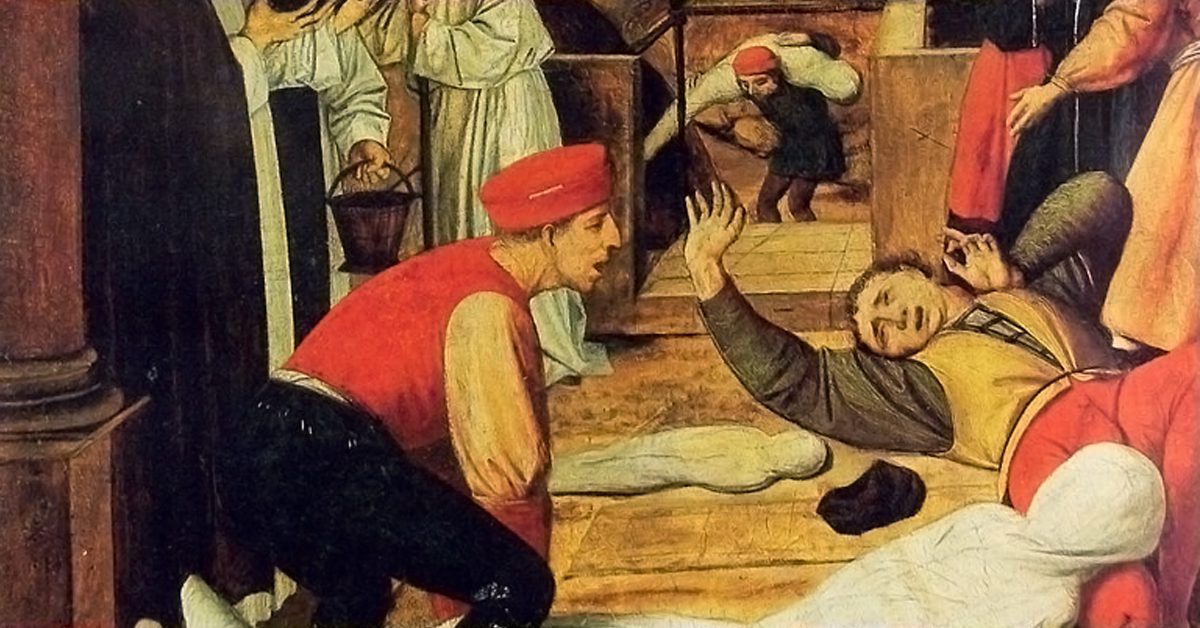
The Story of Thieves
Want to know all about Thieves? How it all started? How it got its name? I know I sure did! Thieves Household Cleaner was my very first purchase from Young Living! But it was my curiosity about its name that made me dig deeper into essential oils. Why the heck would you call a cleaner “THIEVES” ? It was that curiosity that lead me to where I am today. I’m so glad I took this journey. So glad I was curious about why Young Living chose this name.
Supposedly, during the Black Plague of the 16th century, a small band of thieves were caught in the act and brought before the King who forced them to divulge a most curious secret. The thieves had been entering the homes of plague victims and stripping the dead bodies of money, jewelry, and anything else of value that could be found. Although the plague was highly contagious, not one of this morbid band of thieves ever contracted the dread plague even though their thefts had put them in daily contact with the dead bodies of plague victims. The King, eager to protect himself and the Royal Family, demanded to know how the thieves had avoided contracting the plague.
The thieves were from a family from a long line of Apothecaries, perfumers and spice traders. Because of their intimate knowledge of the healing arts, passed down from generation to generation, they were familiar with a combination of specific plant oils that, when rubbed on the body, would protect the body from contracting this most feared and deadly disease. The King offered leniency in exchange for the thieve’s “secret” formula. With that vital information in hand, he was thereby able to protect himself and his family from the deadly plague.
The recipe for the thieves’ oils can still be found in the Royal English Archives to this day. What’s more, this story is not all that unusual. In fact, it is widely known that many perfumers and tanners in 16th century England were also able to escape the Black Plague due to the fact that the powerful, sweet smelling plant oils used in the making of various perfumes and in the scenting of leather goods exhibit phenomenal antiseptic properties.
Young Living Thieves Oil:
Thieves Oil was created by Gary Young in 1992 to provide immune system support. Young recounts the THIEVES formulation history, which was created as a result of his studies at the Warwick University in London.
“ I must tell you that I have read 17 different versions of the Thieves story,”says Gary, “Some that claim there were 4 thieves and others that claim there were 40! Many of these legends took place in the 15th century, but still others put the date in the 18th century. The formula also varied from one story to the next, but through my research, I was led to 4 key botanicals that were mentioned again and again. Those ingredients were clove, cinnamon, rosemary and lemon… 4 of the same ingredients that make up YL THIEVES essential oil today. “ To round off the modern Thieves formula, Gary added eucalyptus radiata which would have been rare back then.
Today, Thieves oil is one of the most popular blends sold by Young Living and possibly the most RECOGNIZED brand in the World of Aromatherapy! There is now a complete line of cleaning products related to the THIEVES essential oil blend including toothpaste, mouthwash, lozenges, dish soap, laundry soap, dishwasher soap, hand soap, fruit and veggie wash… just to name a few!
THIEVES Ingredients: Clove (Syzygium aromaticum), lemon (Citrus limon), cinnamon (Cinnamomum verum), Eucalyptus radiata, and rosemary (Rosmarinus officinalis).”
Pretty amazing, right? I love reading information like this! I love knowing the history of the oil I have grown to love and use!


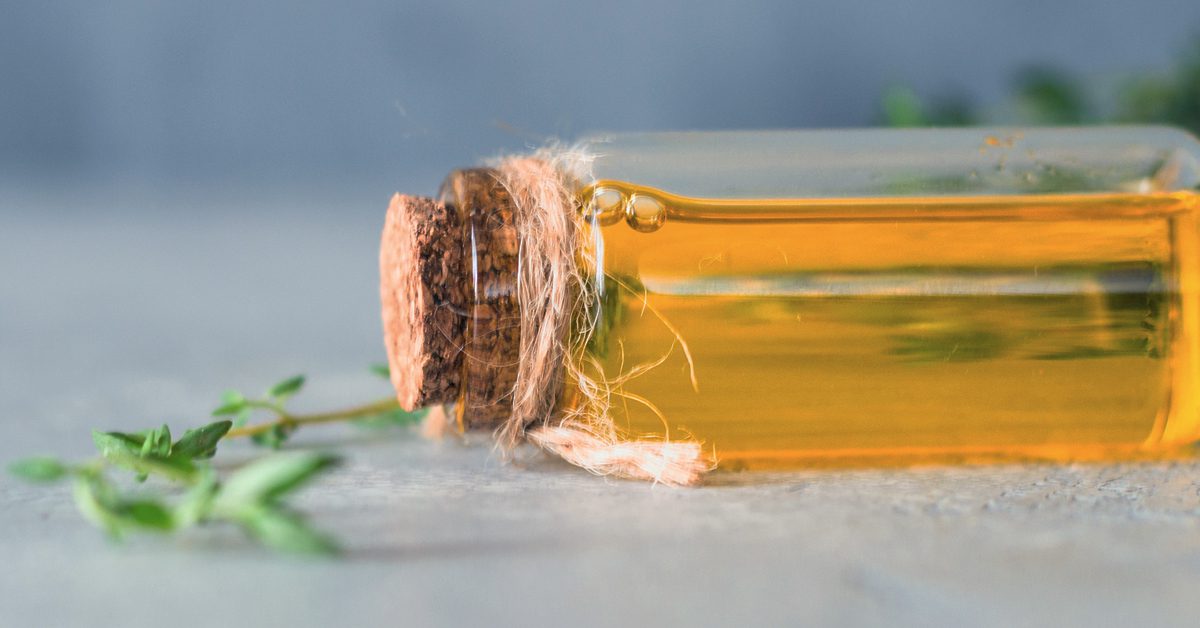








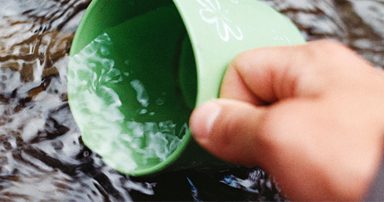









0 Comments